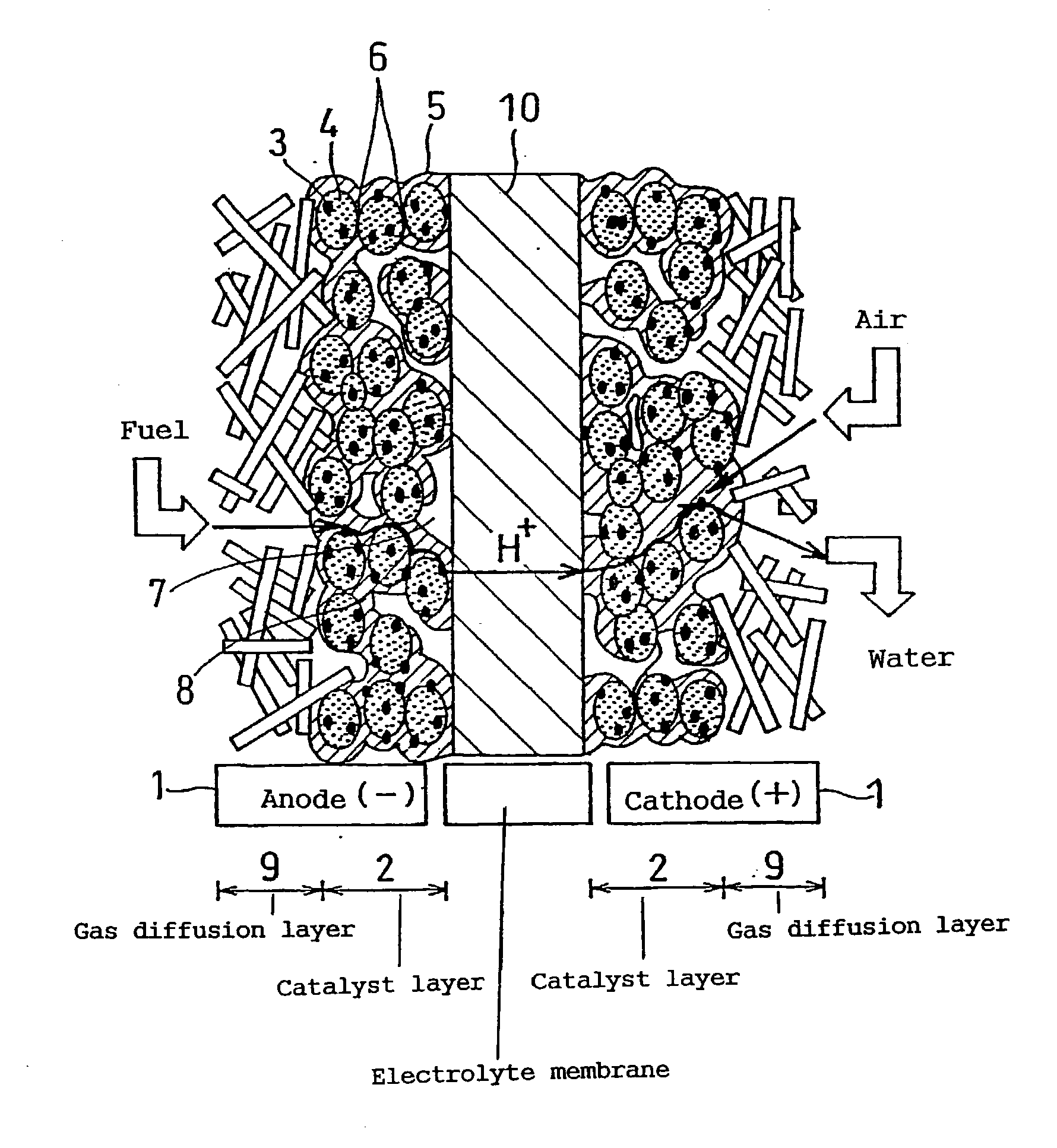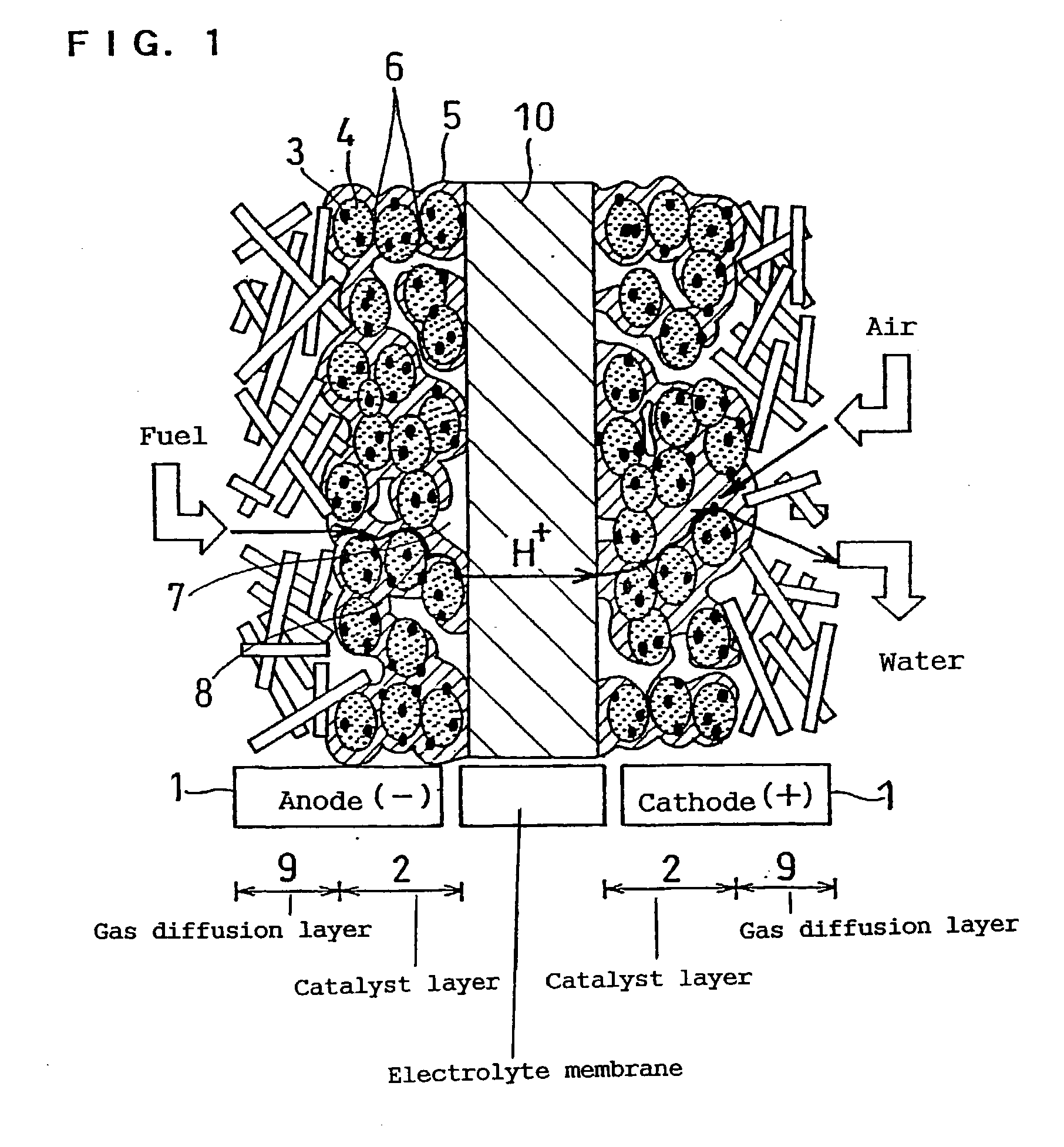Polymer electrolyte fuel cell
a fuel cell and polymer electrolyte technology, applied in the direction of electrochemical generators, cell components, coatings, etc., can solve the problems of unstable cell voltage at a high current density, insufficient reaction area, uneven contact between polymer electrolyte and catalyst, etc., to achieve the effect of increasing reaction area, reducing catalyst waste, and improving performan
- Summary
- Abstract
- Description
- Claims
- Application Information
AI Technical Summary
Benefits of technology
Problems solved by technology
Method used
Image
Examples
example 2
[0074] In this example, a fuel cell was produced using Ketjen Black EC (available from AKZO Chemie, Netherlands), conductive carbon particles with an average primary particle size of 30 nm, as carbon for carrying a catalyst. Other structures and the manufacturing method are the same as in Example 1. This fuel cell is denoted as B.
[0075] Moreover, a similar fuel cell was produced using Ketjen Black 600JD (available from AKZO Chemie, Netherlands), conductive carbon particles with an average primary particle size of 30 nm, as carbon for carrying a catalyst. This fuel cell is denoted as C.
example 3
[0086] Fuel cells were produced in the same manner as in Example 1 by using Vulcan XC-72R and Black pearls 2000 manufactured by Cabot, U.S.A., Conductex 975 manufactured by Columbian Chemicals Company, U.S.A., and acetylene black product Nos. AB1, AB2, AB3 and AB18 manufactured by Denki Kagaku Kogyo K.K. as typical examples of carbon particles with pores in the agglomerate structure having a peak between 5 and 100 nm. These carbon particles are represented by letters f, g, h, I, j, k and l, respectively. When these cells were evaluated by the same method as in Example 1, they exhibited characteristics as good as the cell A.
[0087] The pore distribution of the various carbon particles used in the above-mentioned cells were measured by a mercury penetration method using AoToPore 9220 manufactured by Micromeritics. The results are shown in FIG. 8. In addition, the obtained pore size peak and the specific surface area are shown in Table 1. The carbon particles used in the cells B, C and ...
example 4
[0095] First, a carbon black powder was used as the carbon particles having a primary particle size of not smaller than 10 nm and not greater than 150 nm, and a perfluorosulfonic acid having the chemical structure represented by the following formula (3) was used as the hydrogen ion conductive polymer electrolyte. In the formula (3), m=1, n=2,
5.ltoreq.x.ltoreq.13.5, y=1000. 1
[0096] 80 parts by weight of ethanol in which 9 wt % hydrogen ion conductive polymer electrolyte was dispersed was mixed in a ball mill with 20 parts by weight of the carbon powder so as to prepare an ink for producing electrodes. Next, an ethanol in which 9 wt % hydrogen ion conductive polymer electrolyte was dispersed was casted on a smooth glass substrate, and dried to obtain a hydrogen ion conductive polymer electrolyte membrane with an average film thickness of 25 .mu.m.
[0097] Next, a 10 .mu.m thick porous carbon fabric made of carbon fibers with an average fiber diameter of 5 .mu.m was attached to both sur...
PUM
 Login to View More
Login to View More Abstract
Description
Claims
Application Information
 Login to View More
Login to View More - R&D
- Intellectual Property
- Life Sciences
- Materials
- Tech Scout
- Unparalleled Data Quality
- Higher Quality Content
- 60% Fewer Hallucinations
Browse by: Latest US Patents, China's latest patents, Technical Efficacy Thesaurus, Application Domain, Technology Topic, Popular Technical Reports.
© 2025 PatSnap. All rights reserved.Legal|Privacy policy|Modern Slavery Act Transparency Statement|Sitemap|About US| Contact US: help@patsnap.com



